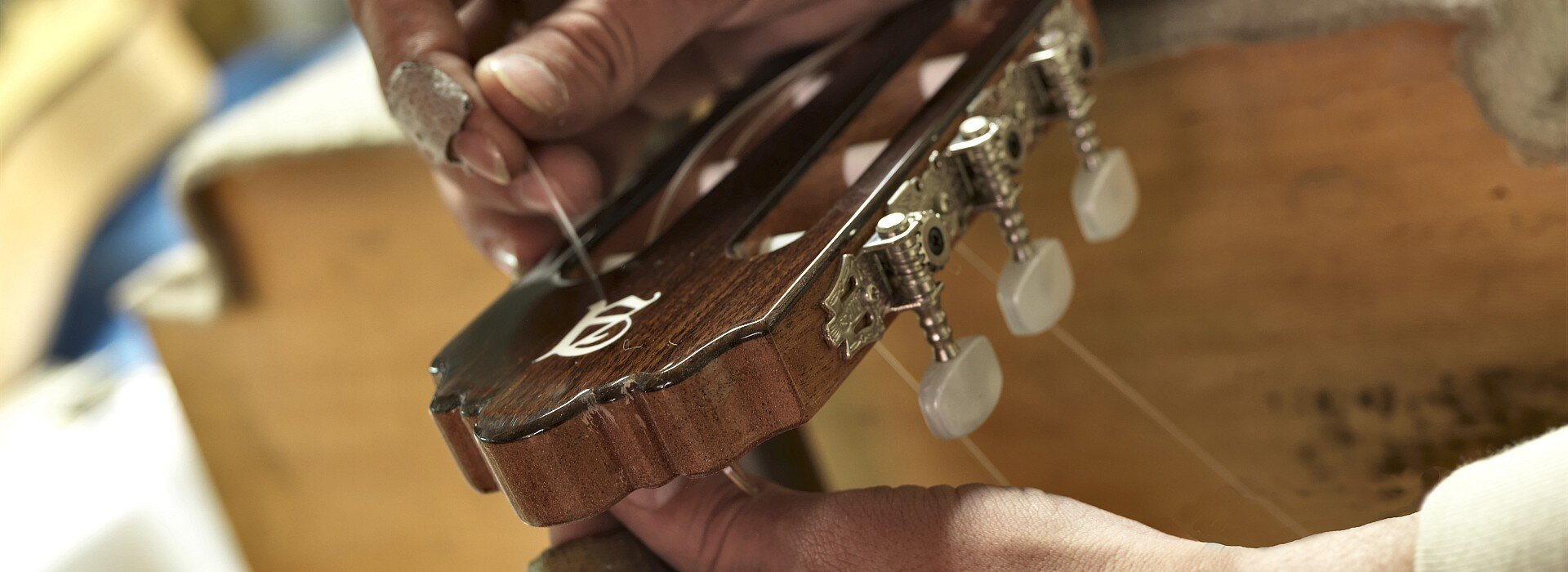Chapter 6. Blessings: The Right Fit
Chapter 6. Blessings: The Right Fit
Personal Encounters with the “Right Fit”
By “Fit,” I mean literally the strings that are “fitted” by the makers of guitars. There is no greater blessing than to purchase a guitar with strings that fit its character and suit your touch, a guitar that sings and plays comfortably with those strings.
Seamless Integration of Strings and Guitar
In fact, in this ideal situation, we hardly even think about the strings because they become part of a seamless relationship between us and the instrument in the production of music. This is a physical/sonic precondition for what Pepe Romero calls becoming “one” with the guitar - strings are the medium of this relationship.
In talking about mental health, negative thoughts, and depressive narcissism, a great psychiatrist once said: “You don’t notice the car windscreen until it’s dirty.” The same thing applies to strings on the guitar. If they suit, you hardly notice them, but if not (a buzz, a rattle, a stifled tone, etc.), then you are forced to become aware of obstacles.
Personal Experiences with the “Right Fit”
Among over twenty guitars I’ve owned, I have had the good fortune to buy about four (new) that had strings with the “right fit” from the very beginning, in terms of tensions, tone, and texture. The reason why I am talking about “fit” and new guitars is that they have helped to educate my ears and fingers, giving me a base to evaluate my playing relationship with other guitars – though admittedly I haven’t entirely avoided making poor decisions with other guitar purchases. I guess progress never occurs along a completely upward curve!
Examples of Ideal Guitar-String Matches
The first of my guitars that felt right with its strings (i.e., as a total sound package) was an Alhambra 4P, with a solid spruce top and laminated Indian rosewood back and sides. Regardless of the limitations of the laminated back and sides, this guitar was ideal at that stage of my playing. I was transitioning from a basic model laminated Yamaha, followed by a quite nice cedar top, but laminated, Katoh.
I had improved these previous guitars with good quality Savarez normal tension nylon strings, but I certainly needed a more resonant guitar at that stage. I was returning to the guitar after a twenty-year detour into studying Indian sitar; so I wasn’t prepared to fork out many thousands of dollars on a top-line guitar until I had restored my technique.
Amazingly to me, although this Alhambra 4P was quite comfortable to play, it was fitted with Alhambra brand (i.e., D’Addario) Extra High-tension strings. But, they did not feel excessively rigid under my fingers. Apart from a fairly thick neck (which Alhambra has since reduced), everything was right: the action, the neck angle, the projection, and the sustain.
The Alhambra factory (and its high-end boutique workshops) still fits its guitars with these extra high-tension strings, and they always sound and feel good, especially the high-end models like the “José Maria Vilaplana NT.”
So, HERE’S THE LESSON: Alhambra is a firm that has obviously given a lot of attention to the guitar/string relationship: it is even possible to say that they have built their guitars around these Extra High-tension strings. This is even more intriguing to me because normally I don’t like the feel or the tone of D’Addario strings when I’ve used them on other guitars. In fact, D’Addario strings are one of my least favourite brands, which I only use in an emergency – more on this later.
There are a few other guitars (two of them I still own) that have had the “right fit,” and I have never had to agonize about changing to alternative strings. One was my first all-solid guitar, a cedar-top/Indian rosewood Juan Hernandez “Professor” (made in one of the Esteve workshops).
Everything felt right about the tension, feel, and sonority of the strings with this guitar. It came with Savarez Cristal Corum strings, with high-tension Corum basses and normal tension trebles. The high-tension basses gave a nice punch and volume when needed, while the normal tension nylon trebles gave enough volume and tone for my needs. I have always found Savarez nylon treble strings to be a good choice when matched with the right guitar.
In this case, obviously the luthier workshop had chosen strings that matched well with the capacity of the guitar top, the neck angle and relief, and the bracing (it was a traditional fan-braced guitar). At that time, I had not yet experimented with Savarez’ alternative bass string, the Cantiga. Even at the same nominal “normal tension” as the Corum basses, the Cantiga basses have more rigid nylon filaments inside the windings, giving a slightly higher tension and a snappier ring.
I sold this guitar, not because I didn’t like it anymore, but simply because I was lusting after another, and I needed to fund the new purchase. Such is life.
Another of my guitars which enjoys the “right fit” is a 64CM scale length all-solid cedar/Indian rosewood guitar made by Angel Benito Aguardo, his so-called “Marizapalos” model. It is a traditional fan-braced Spanish guitar with a lovely smooth resonance. As-new, it came fitted with Savarez Corum Cristal Normal tension strings (500CR). So again, all nylon strings.
These are ideal for me. Even though the Savarez tension designation is based on a 65CM scale length, the strings do not feel slack on this 64CM scale guitar. One might have expected the basses to rattle a bit, especially the D string, but they do not, which highlights how well the neck angle and relief have been designed to accommodate these normal tension Savarez nylon strings.
A dead giveaway for strings with too low a tension for a guitar is that they will slip off the edge of the fingerboard when playing certain passages with the high E-string. Anyway, this Aguardo guitar with the Savarez normal tension nylon trebles has just the right tension and resonance. I like this guitar and its string configuration for playing nineteenth-century repertoire, from Giuliani up to Tarrega. It is intimate and warm and doesn’t lack projection either. I’ve never felt the need to experiment with alternative brands of strings on this guitar. If it ain’t broke, don’t fix it!
Note, for some reason, in recent years the Aguardo workshop has started to fit Savarez carbon trebles to this model. I avoid carbon trebles because to me they feel and sound too thin. If at the beginning, I had encountered this guitar with carbon treble strings I may not have bought it. Does that seem picky or trivial? Not for me - when over $4,000 is at stake in a guitar purchase decision.
Another guitar with a great match with the original fitted strings is my concert guitar, the “Catedral” model made by Manual Adalid. This is a French polished cedar/Indian rosewood double-top guitar which I purchased from Guitarras De Luthier in Madrid after two weeks of comparing with other guitars of similar price range (then 9000 Euros, or around $AU13,000).
I was entranced by its tone, even though the more rigid double top demanded a somewhat different approach to playing than my preferred traditional fan-braced guitars. Coincidentally, this was also fitted with Savarez nylon normal tension strings and I have never felt the need to change string tension or brand on this guitar.
The characteristic of lattice and double-top guitars is that the stiffened soundboard produces an immediate response, almost metallic in tone. To my ear, carbon treble strings on lattice/double tops accentuate this tone thinness even further, so I prefer to soften this as much as possible by using nylon strings, at least for the high E and B trebles. With the Adalid Catedral I never had to consider this issue, but I have done so with other lattice models that I have owned.
Selecting Guitars and Strings Wisely
There is a glaringly obvious point to be made here about my encounters with the right guitar-string fit – with me anyway – I chose all of these guitars by playing them directly in specialist classical guitar showrooms. When it comes to buying instruments that we haven’t played prior to purchase – i.e., online sale – there are always risks, unless we are ordering instruments from highly reputable luthiers.

